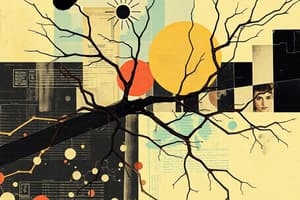Podcast
Questions and Answers
What happens after an action potential travels down the axon?
What happens after an action potential travels down the axon?
- It triggers muscle contractions
- It causes calcium to enter the cell
- It releases acetylcholine
- It reaches the axon terminal (correct)
What enters the axon terminal when electrically gated calcium channels open?
What enters the axon terminal when electrically gated calcium channels open?
Calcium
What does calcium cause the vesicles to release?
What does calcium cause the vesicles to release?
ACH
ACH binds to receptors on the muscle after diffusing across the synaptic cleft.
ACH binds to receptors on the muscle after diffusing across the synaptic cleft.
What happens when ACH binding opens ion channels?
What happens when ACH binding opens ion channels?
What occurs if the muscle reaches the threshold of -55mV at the motor end plate?
What occurs if the muscle reaches the threshold of -55mV at the motor end plate?
Who breaks down ACH?
Who breaks down ACH?
Flashcards are hidden until you start studying
Study Notes
Neuromuscular Junction: Steps of Action Potential Transmission
- An action potential (AP) travels down the axon to the axon terminal, initiating neurotransmitter release.
- Voltage-gated calcium channels open in response to the AP, allowing calcium ions to enter the axon terminal.
- The influx of calcium ions triggers vesicles to release acetylcholine (ACh) into the synaptic cleft.
- Acetylcholine diffuses across the synaptic cleft and binds to its receptors on the muscle fibers.
- Binding of ACh to receptors opens ion channels, resulting in sodium ions rushing into the muscle cells.
- If the muscle reaches the threshold of -55mV at the motor end plate, it generates an action potential in the muscle.
- Acetylcholine is broken down by acetylcholine esterase, terminating the signal and preventing continuous stimulation.
Studying That Suits You
Use AI to generate personalized quizzes and flashcards to suit your learning preferences.




